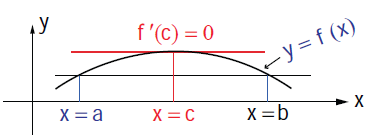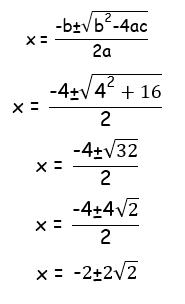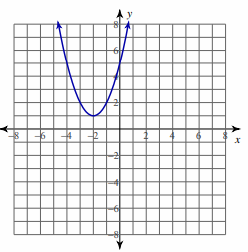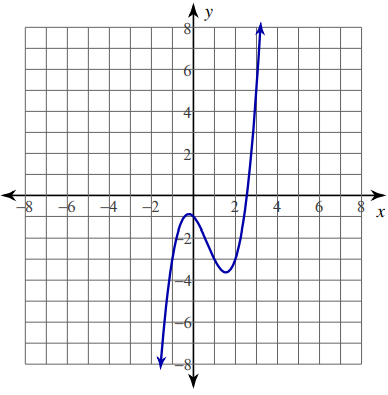SOLVING PROBLEMS USING ROLLES THEOREM
Let f (x) be continuous on a closed interval [a, b] and differentiable on the open interval (a, b)
If f(a) = f(b)
then there is at least one point c ∈ (a,b) where f '(c) = 0.
Geometrically this means that if the tangent is moving along the curve starting at x = a towards x = b then there exists a c ∈ (a, b) at which the tangent is parallel to the x -axis.

Using the Rolle’s theorem, determine the values of x at which the tangent is parallel to the x -axis for the following functions :
Problem 1 :
f(x) = x2 − x, x ∈ [0, 1]
Solution :
f(x) is defined and continuous on the closed interval [0, 1] and it is differentiable on (0, 1).
|
f(x) = x2 − x f(0) = 02 − 0 f(0) = 0 ---(1) |
f(x) = x2 − x f(1) = 12 − 1 f(1) = 0 ---(2) |
(1) = (2)
So, there is at least one point c ∈ [0, 1]
f'(c) = 2x-1
2c-1 = 0
2c = 1
c = 1/2
Problem 2 :
f(x) = (x2 - 2x)/(x + 2), x ∈ [-1, 6]
Solution :
f(x) is defined and continuous on the closed interval [-1, 6] and it is differentiable on (-1, 6).
|
f(-1) = (1+2)/1 f(-1) = 3 ----(1) |
f(6) = 24/8 f(-1) = 3----(2) |
(1) = (2)
So, there is at least one point c ∈ [-1, 6]
f'(x) = [(x+2) (2x-2) - (x2-2x) (1)] / (x+2)2
f'(x) = (2x2+2x-4 - x2+2x) / (x+2)2
f'(x) = (x2+4x-4) / (x+2)2
f'(x) = 0
x2 + 4x - 4 = 0

So, the solutions are -2±2√2.
Problem 3 :
f(x) = √x - (x/3), x∈ [0, 9]
Solution :
f(x) is defined and continuous on the closed interval [0, 9] and it is differentiable on (0, 9).
|
f(0) = (1+2)/1 f(-1) = 3 ----(1) |
f(6) = 24/8 f(-1) = 3----(2) |
(1) = (2)
So, there is at least one point c ∈ [-1, 6]
f(x) = √x - (x/3)
f'(x) = 1/2√x - (1/3)
1/2√x - (1/3) = 0
1/2√x = 1/3
3 = 2√x
√x = 3/2
x = 9/4 ∈ [-1, 6]
For each problem, find the values of c that satisfy Rolle's Theorem.
Problem 4 :
y = x2 + 4x + 5; [−3, −1]

Solution :
i) The given function y is defined and continuous on the closed interval [-3, -1].
ii) Let f(x) = y = x2 + 4x + 5
f'(x) = 2x + 4(1) + 0
f'(x) = 2x + 4
It is differentiable in the open interval (-3, -1).
iii)
|
f(x) = x2 + 4x + 5 f(-1) = (-1)2 + 4(-1) + 5 = 1 - 4 + 5 f(-1) = 2 |
f(x) = x2 + 4x + 5 f(-3) = (-3)2 + 4(-3) + 5 = 9 - 12 + 5 f(-3) = 2 |
f(-1) = f(-3)
So, there must be c in the interval [-3, -1].
f'(c) = 0
2c + 4 = 0
2c = -4
c = -4/2
c = -2
So, the value of c is -2.
Problem 5 :
y = x3 - 2 x2 - x - 1; [−1, 2]

Solution :
i) The given function y is defined and continuous on the closed interval [-1, 2].
ii) Let f(x) = y = x3 - 2 x2 - x - 1
f'(x) = 3x2 - 2(2x) - 1 - 0
f'(x) = 3x2 - 4x - 1
It is differentiable in the open interval (-1, 2).
iii) f(x) = x3 - 2 x2 - x - 1
f(-1) = (-1)3 - 2 (-1)2 - (-1) - 1
= -1 - 2 + 1 - 1
= -3 ----(1)
f(2) = 23 - 2 (2)2 - 2 - 1
= 8 - 2(4) - 2 - 1
= 8 - 8 - 3
= -3 -----(2)
It satisfies all the condition, so there must be c in the interval [-1, 2].
3x2 - 4x - 1 = 0
Solving this quadratic equation using formula,
a = 3, b = -4 and c = -1
= (-b ± √b2 - 4ac)/2a
= 4 ± [√(-4)2 - 4(3)(-1)]/2(3)
= 4 ± [√(16 + 12)]/6
= 4 ± √28/6
= (4 ± 2√7)/6
= (2 ± √7)/3
So, the required values of c are (2 + √7)/3 and (2 - √7)/3.
Problem 6 :
y = -2 sin (2x) [−π, π]
Solution :
i) The given function y is defined and continuous on the closed interval [−π, π]
ii) Let f(x) = y = -2 sin (2x)
f'(x) = -2 cos (2x)(2)
f'(x) = -4 cos 2x
It is differentiable in the open interval (−π, π).
iii) f(x) = -2 sin (2x)
f(−π) = -2 sin (-2π)
= 2 sin (2π)
= 2(0)
= 0 -----(1)
f(π) = -2 sin (2π)
= -2 sin (2π)
= -2(0)
= 0 -----(2)
(1) = (2)
It satisfies all the condition, so there must be c in the interval [-π, π].
-4 cos 2x = 0
cos (2x) = 0
2x = cos-1(0)
2x = -π/2, -3π/2, π/2, 3π/2
x = -π/4, -3π/4, π/4, 3π/4
Problem 7 :
y = cos (2x) [π/3, 2π/3]
Solution :
i) The given function y is defined and continuous on the closed interval [π/3, 2π/3]
ii) Let f(x) = y = cos (2x)
f'(x) = -sin (2x)(2)
f'(x) = -2 sin 2x
It is differentiable in the open interval [π/3, 2π/3]
iii) f(x) = cos (2x)
f(π/3) = cos (2π/3)
= -1/2 -----(1)
f(2π/3) = cos (4π/3)
= cos (π + π/3)
= cos π/3
= -1/2 -----(2)
It satisfies all the condition, so there must be c in the interval [π/3, 2π/3].
-2 sin 2x = 0
sin (2x) = 0
2x = sin-1(0)
2x = π, 2π
x = π/2, 2π/2
x = π/2, π
So, the value of c is π/2.
Kindly mail your feedback to v4formath@gmail.com
We always appreciate your feedback.
©All rights reserved. onlinemath4all.com
Recent Articles
-
10 Hard SAT Math Questions (Part - 34)
Nov 15, 25 08:00 AM
10 Hard SAT Math Questions (Part - 34) -
Algebra Word Problems Worksheet with Answers
Nov 10, 25 06:30 PM
Algebra Word Problems Worksheet with Answers -
Tricky SAT Math Problems Solved Easily
Nov 09, 25 07:02 PM
Tricky SAT Math Problems Solved Easily


